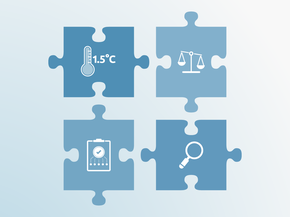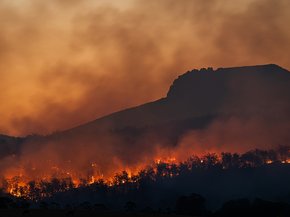Country summary
Overview
With Bhutan being a carbon negative country due to its large land sink, it is already compliant with its NDC target of remaining carbon (and GHG) neutral. While the COVID-19 pandemic caused a temporary drop in its emissions, we project that Bhutan's emissions will resume increasing over the course of the decade without additional policies. If allowed to increase unchecked, especially in the industry and transport sectors, they could exceed the level that is sequestered by forests. We rate Bhutan as ‘Almost sufficient’ overall.
In its second NDC, Bhutan reiterates its carbon neutrality goal, has developed sectoral emission reduction plans for all sectors, and has begun implementing measures on its transport and agriculture sectors. The full implementation of these measures falls within our 1.5°C compatible category for the level of emissions reductions needed within Bhutan’s borders. Bhutan needs international support to fully implement all of these measures.
Recent developments include:
- Construction of the country’s first utility-scale solar plant, which is set to begin in the first half of 2023. The 17 MW plant is part of a broader government initiative to install 300 MW of solar over the next three years. These efforts will help diversify the largely hydropower-based grid and reduce reliance on winter energy imports.
- Geological uncertainties are delaying operations of under-construction hydro power projects, resulting in an escalation of project costs and mounting national debt. This calls for a diversification towards non-hydro renewable energy.
- Advancing on its electric vehicle (EV) policies, as the government has started setting up EV charging stations and supporting a shift to EVs in the taxi industry. These actions build on other efforts taken in the transport sector last year to strengthen vehicle emission standards, though some initiatives, like the rapid mass transit system, have not advanced.
- Expansion of its biogas production. Bhutan will establish a biogas plan as part of a new landfill in its capital city this year. It is promoting domestic biogas production in both its agriculture and waste management sectors.
- Bhutan has recently embarked on a strategy to develop its industrial parks and emissions are expected to grow significantly in this sector. The government has identified a number of mitigation measures it could take, with support, in its low-emissions industry strategy, but we could not find any evidence that it has begun to implement these.
The CAT rates Bhutan’s climate targets and policies as “Almost sufficient”. The “Almost sufficient” rating indicates that Bhutan’s climate commitments and policies are not yet consistent with limiting warming to 1.5°C, but could be with moderate improvements. This rating is based on a modification of the CAT’s standard approach to reflect the fact that Bhutan is already carbon neutral and to provide a more accurate picture of Bhutan’s emissions trajectory and actions. Details are provided under the targets page. Bhutan is close to a 1.5°C compatible rating, but would need to slow its emissions growth to achieve this rating. Bhutan will need international support to fully implement its policies and action.
We rate Bhutan’s current policies and action as “1.5°C compatible” compared to its fair share contribution. The “1.5°C compatible” rating indicates that Bhutan’s climate policies and action are consistent with limiting warming to 1.5°C. However, there is significant potential for mitigation actions to go beyond Bhutan’s fair share if the needed international support is provided.
Bhutan’s economy-wide emissions dropped by around 40% between 2019-2021 due to the COVID-19 pandemic-induced slowing down of economic activity. We project that emissions will resume increasing over the course of the decade, reaching around 2.8-3.0 MtCO2e/year in 2030 - an increase of 76-85% from 2010 level.
Bhutan has developed sectoral low-emission development plans, but the exact status of implementation of these plans can be difficult to determine. Bhutan is expanding its solar capacity to diversify its power generation. Electrification of the transport sector with increasing number of electric taxis and private vehicle is part of government plan along with expansion of charging infrastructure. In 2019, Bhutan adopted its Energy Efficiency and Conservation Roadmap. Mitigation potential for some of these measures is included in our assessment of current policies and action. Other sectoral policy actions include forest conservation and management under the National REDD+ Strategy.
Bhutan will remain compliant with its NDC target of staying carbon (and GHG) neutral with currently implemented policies.
As Bhutan has already achieved its carbon neutral NDC target, rating this NDC target level (excluding the contribution of the forestry sector) based on the current net emissions produces misleading results, thus we have adopted an alternative method.
We rate where Bhutan’s emissions will be in 2030 if its sectoral measures from NDC are fully implemented against where its emissions would need to be based on a global least cost modelled domestic pathway for 1.5°C. The “1.5°C global least cost” rating indicates that Bhutan’s emissions in 2030 are consistent with modelled domestic pathways limiting warming to 1.5°C.
We rate where Bhutan’s emissions will be in 2030 under a business-as-usual trajectory (not current policies) against Bhutan’s fair share contribution level. Our rating is based on the top end of this range and is "Almost sufficient". The “Almost sufficient” rating indicates that Bhutan’s emissions in 2030 are not yet consistent with limiting warming to 1.5°C but could be, with moderate improvements. If all countries were to follow Bhutan's approach, warming could be held below—but not well below—2°C. Bhutan has the potential to achieve a 1.5°C compatible rating if it manages to slow its emissions growth.
In 2020, Bhutan had a net carbon sink capacity of 8.9 MtCO2e which is pivotal for its carbon neutrality pledge. Bhutan implemented the REDD+ readiness programme and produced Bhutan’s National REDD+ Strategy and implementation framework. Forests currently cover 70% of Bhutan’s land, and it has a constitutional mandate to maintain this share above 60%.
Bhutan first committed to remaining carbon neutral during COP15, in Copenhagen in 2009. In its second NDC, Bhutan adopted a net zero emissions by 2050 goal, which is essentially an extension of its carbon neutrality target and which it has already achieved. Bhutan is currently developing its long-term strategy which will be important to develop sectoral policies particularly for the energy and industry sector to curb the emissions. Until that strategy is released, we classify Bhutan’s net zero target as “information incomplete”.
Further analysis
Latest publications
Stay informed
Subscribe to our newsletter






